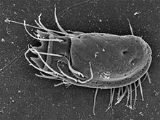
Stephanopogon
Encyclopedia
Stephanopogon is a peculiar marine protozoa
n.
s and was originally classified with them, but is now considered a flagellate
. The cell is somewhat flattened, with multiple smooth flagella arranged in rows running from the front to the back, and has an anterior mouth supported by rods. They feed on bacteria, diatom
s, and other smaller organisms. There are 2-16 nuclei
, but they are not differentiated into macronuclei and micronuclei as occurs in ciliates.
with discoid crista
e and lacks dictyosome
s, like the Percolozoa
. These morphological comparisons are consistent with the molecular phylogenetic analyses by Yubuki and Leander, which demonstrated that Stephanopogon is closely related to Percolomonas within the Heterolobosea.
It has recently been placed in the class
Percolatea, along with Percolomonas
.
Protozoa
Protozoa are a diverse group of single-cells eukaryotic organisms, many of which are motile. Throughout history, protozoa have been defined as single-cell protists with animal-like behavior, e.g., movement...
n.
Characteristics
It closely resembles certain ciliateCiliate
The ciliates are a group of protozoans characterized by the presence of hair-like organelles called cilia, which are identical in structure to flagella but typically shorter and present in much larger numbers with a different undulating pattern than flagella...
s and was originally classified with them, but is now considered a flagellate
Flagellate
Flagellates are organisms with one or more whip-like organelles called flagella. Some cells in animals may be flagellate, for instance the spermatozoa of most phyla. Flowering plants do not produce flagellate cells, but ferns, mosses, green algae, some gymnosperms and other closely related plants...
. The cell is somewhat flattened, with multiple smooth flagella arranged in rows running from the front to the back, and has an anterior mouth supported by rods. They feed on bacteria, diatom
Diatom
Diatoms are a major group of algae, and are one of the most common types of phytoplankton. Most diatoms are unicellular, although they can exist as colonies in the shape of filaments or ribbons , fans , zigzags , or stellate colonies . Diatoms are producers within the food chain...
s, and other smaller organisms. There are 2-16 nuclei
Cell nucleus
In cell biology, the nucleus is a membrane-enclosed organelle found in eukaryotic cells. It contains most of the cell's genetic material, organized as multiple long linear DNA molecules in complex with a large variety of proteins, such as histones, to form chromosomes. The genes within these...
, but they are not differentiated into macronuclei and micronuclei as occurs in ciliates.
Classification
Because the nuclei are homogeneous, Stephanopogon has previously been regarded as an evolutionary intermediate between the ciliates and other protozoa, and possibly an ancestor of the animals as well. However, Corliss and Lipscomb showed that it is not related to ciliates, and lacks their complex pellicle and infraciliature. Stephanopogon has mitochondriaMitochondrion
In cell biology, a mitochondrion is a membrane-enclosed organelle found in most eukaryotic cells. These organelles range from 0.5 to 1.0 micrometers in diameter...
with discoid crista
Crista
Cristae are the internal compartments formed by the inner membrane of a mitochondrion. They are studded with proteins, including ATP synthase and a variety of cytochromes. The maximum surface for chemical reactions to occur is within the mitochondria...
e and lacks dictyosome
Golgi apparatus
The Golgi apparatus is an organelle found in most eukaryotic cells. It was identified in 1898 by the Italian physician Camillo Golgi, after whom the Golgi apparatus is named....
s, like the Percolozoa
Percolozoa
The Percolozoa are a group of colourless protozoa, including many that can transform between amoeboid, flagellate, and encysted stages.-Terminology and classification:...
. These morphological comparisons are consistent with the molecular phylogenetic analyses by Yubuki and Leander, which demonstrated that Stephanopogon is closely related to Percolomonas within the Heterolobosea.
It has recently been placed in the class
Class (biology)
In biological classification, class is* a taxonomic rank. Other well-known ranks are life, domain, kingdom, phylum, order, family, genus, and species, with class fitting between phylum and order...
Percolatea, along with Percolomonas
Percolomonas
Percolomonas is a genus of free-living flagellate Heteroloboseans, forming a clade with Stephanopogon.It includes the species Percolomonas cosmopolitus....
.

